A 600 W Photovoltaic Groundwater Pumping System Based on LLC Converter and Constant Voltage MPPT
Abstract
:1. Introduction
1.1. Project Scope
1.2. Literature Review
1.3. Motivation for Present Work
1.4. Objectives of Present Work
- Can a resonant two-inductors one-capacitor (LLC) DC-DC converter operate with fixed duty-cycle and frequency for a photovoltaic water pumping application?
- Can Silicon Carbine MOSFETs be used to solve startup issues with a resonant LLC DC-DC converter?
- Is the use of an auxiliary panel appropriate to operate a constant voltage MPPT algorithm? Can this be used with a photovoltaic water pumping system?
2. Materials and Methods
2.1. System Requirements
2.2. System Overview and Converter Design
2.3. MPPT and V/f Control
3. Results and Discussion
3.1. Simulation Results
3.2. Experimental Results
3.3. Discussions
3.4. Cost Analysis
3.5. System Feasibility
4. Conclusions
Author Contributions
Funding
Data Availability Statement
Acknowledgments
Conflicts of Interest
References
- The United Nations World Water Development Report 2022: Groundwater: Making the Invisible Visible. Available online: https://unesdoc.unesco.org/ark:/48223/pf0000380721 (accessed on 10 May 2023).
- Energy Transitions: Lighting in Vanuatu 2014. Available online: http://hdl.handle.net/10523/4859 (accessed on 10 May 2023).
- Palmiro, F.; Rayudu, R.; Ford, R. Modelling and simulation of a solar PV lithium ion battery charger for energy kiosks application. In Proceedings of the 2015 14th IEEE PES Asia-Pacific Power and Energy Engineering Conference 2022 (APPEEC), Melbourne, Australia, 20–23 November 2022. [Google Scholar] [CrossRef]
- Maddalena, E.T.; da Silva Moraes, C.G.; Bragança, G.; Junior, L.G.; Godoy, R.B.; Pinto, J.O.P. A battery-less photovoltaic water-pumping system with low decoupling capacitance. IEEE Trans. Ind. Appl. 2019, 55, 2263–2271. [Google Scholar] [CrossRef]
- Caracas, J.V.M.; Farias, G.d.C.; Teixeira, L.F.M.; Ribeiro, L.A.d.S. Implementation of a High-Efficiency, High-Lifetime, and Low-Cost Converter for an Autonomous Photovoltaic Water Pumping System. IEEE Trans. Ind. Appl. 2014, 50, 631–641. [Google Scholar] [CrossRef]
- Chen, R.; Brohlin, P.; Dapkus, D. Design and magnetics optimization of LLC resonant converter with GaN. In Proceedings of the 2017 IEEE Applied Power Electronics Conference and Exposition (APEC), Tampa, FL, USA, 26–30 March 2017; pp. 94–98. [Google Scholar]
- Lu, J.; Tong, X.; Shen, M.; Yin, J.; Yuan, Y. The Phase Shifting Soft Startup of L-LLC Resonant Bidirectional DC-DC Converter Based on Current-Limiting Curve. Math. Probl. Eng. 2021, 9, 6632743. [Google Scholar] [CrossRef]
- Palmiro, F.; Pinto, J.O.P.; Pereira, L.H.; Godoy, R.B. Cost-effective photovoltaic water pumping system for remote regions communities. In Proceedings of the 2014 IEEE Energy Conversion Congress and Exposition (ECCE 2014), Pittsburgh, PA, USA, 14–18 September 2014; pp. 3287–3293. [Google Scholar]
- Kimpara, M.L.M.; Palmiro, F.; Bizarro, D.B.; Galotto, L.; Godoy, R.B. Three-phase Tri-State Current Source Inverter for photovoltaic energy stand-alone applications. In Proceedings of the IECON 2011-37th Annual Conference of the IEEE Industrial Electronics Society, Melbourne, VIC, Australia, 7–10 November 2011; pp. 1642–1647. [Google Scholar]
- Resonant LLC Converter: Operation and Design. Available online: https://www.infineon.com/dgdl/Application_Note_Resonant+LLC+Converter+Operation+and+Design_Infineon.pdf?fileId=db3a30433a047ba0013a4a60e3be64a1 (accessed on 10 May 2023).
- Park, C.W.; Han, S.K. Analysis and design of an integrated magnetics planar transformer for high power density LLC resonant converter. IEEE Access 2021, 9, 157499–157511. [Google Scholar] [CrossRef]
- Zhao, S.; Li, Q.; Lee, F.C.; Li, B. High-frequency transformer design for modular power conversion from medium-voltage AC to 400 VDC. IEEE Trans. Power Electron. 2017, 33, 7545–7557. [Google Scholar] [CrossRef]
- De Brito, M.A.G.; Galotto, L.; Sampaio, L.P.; Melo, G.D.A.; Canesin, C.A. Evaluation of the main MPPT techniques for photovoltaic applications. IEEE Trans. Ind. Electron. 2012, 60, 1156–1167. [Google Scholar] [CrossRef]
- Zhuang, Y.; Liu, F.; Zhang, X.; Diao, X.; Jiang, J.; Sun, J. Direct Frequency Control Based MPPT Algorithm of LLC Resonant Converter for Photovoltaic System. In Proceedings of the IEEE Energy Conversion Congress and Exposition (ECCE 2019), Baltimore, MD, USA, 29 September–3 October 2019; pp. 3402–3406. [Google Scholar]
- Wei, Y.; Luo, Q.; Mantooth, A. Comprehensive analysis and design of LLC resonant converter with magnetic control. CPSS Trans. Power Electron. Appl. 2019, 4, 265–275. [Google Scholar] [CrossRef]
- Çalışkan, E.; Ustun, O. Smart Efficiency Tracking for Novel Switch—LLC Converter for Battery Charging Applications. Energies 2022, 15, 1861. [Google Scholar] [CrossRef]
- Yoon, D.; Lee, S.; Cho, Y. Design Considerations of Series-Connected Devices Based LLC Converter. Energies 2020, 13, 264. [Google Scholar] [CrossRef] [Green Version]
- Mahjoubi, A.; Fethi Mechlouch, R.; Ben Brahim, A. A Low Cost Wireless Data Acquisition System for a Remote Photovoltaic (PV) Water Pumping System. Energies 2011, 4, 68–89. [Google Scholar] [CrossRef] [Green Version]
- Garcia-Reyes, L.A.; Beltrán-Telles, A.; Bañuelos-Ruedas, F.; Reta-Hernández, M.; Ramírez-Arredondo, J.M.; Silva-Casarín, R. Level-Shift PWM Control of a Single-Phase Full H-Bridge Inverter for Grid Interconnection, Applied to Ocean Current Power Generation. Energies 2022, 15, 1644. [Google Scholar] [CrossRef]
- Tripathi, P.R.; Thakura, P.; Laxmi, V.; Keshri, R.K. Stand-alone PV Water Pumping System based on high-gain resonant inverter fed induction motor serving two-head for permanent water supply. Int. J. Circuit Theory Appl. 2021, 49, 2494–2514. [Google Scholar] [CrossRef]
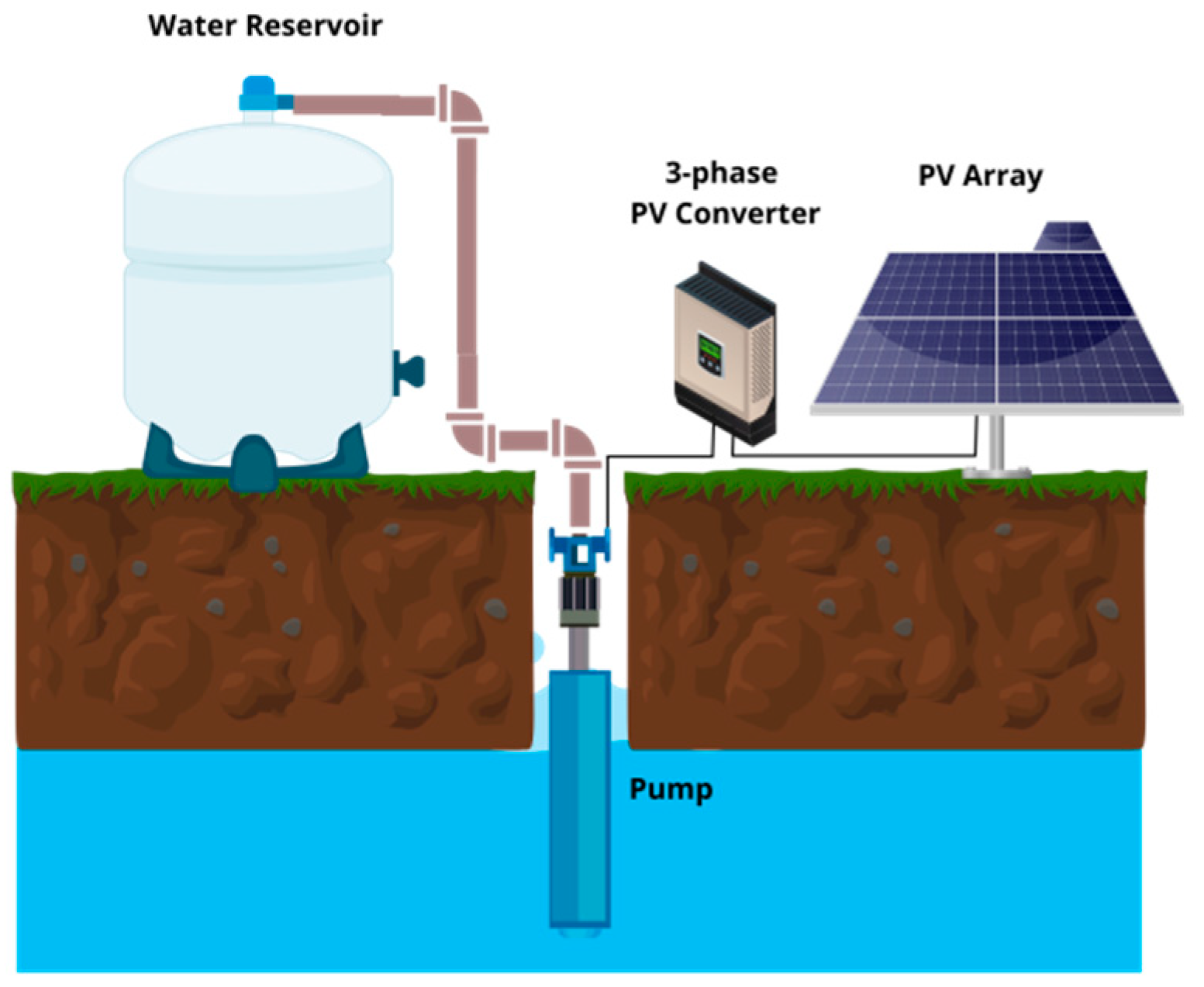
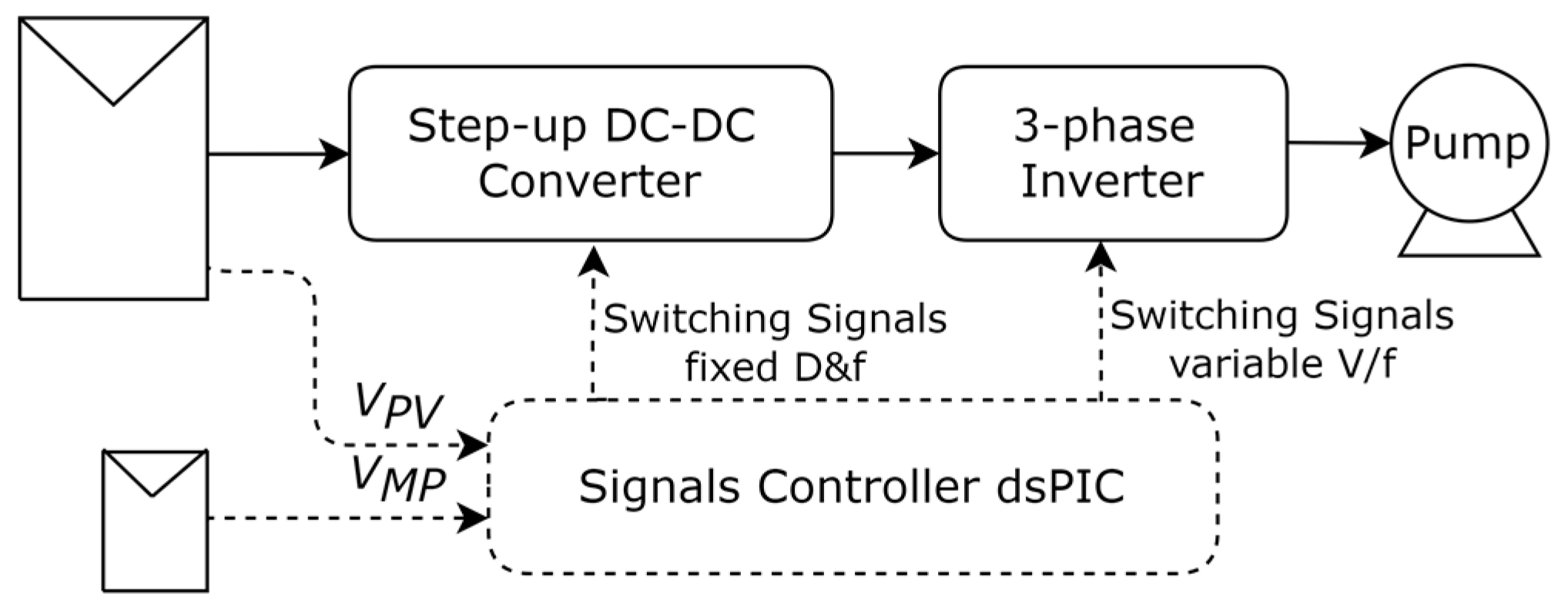


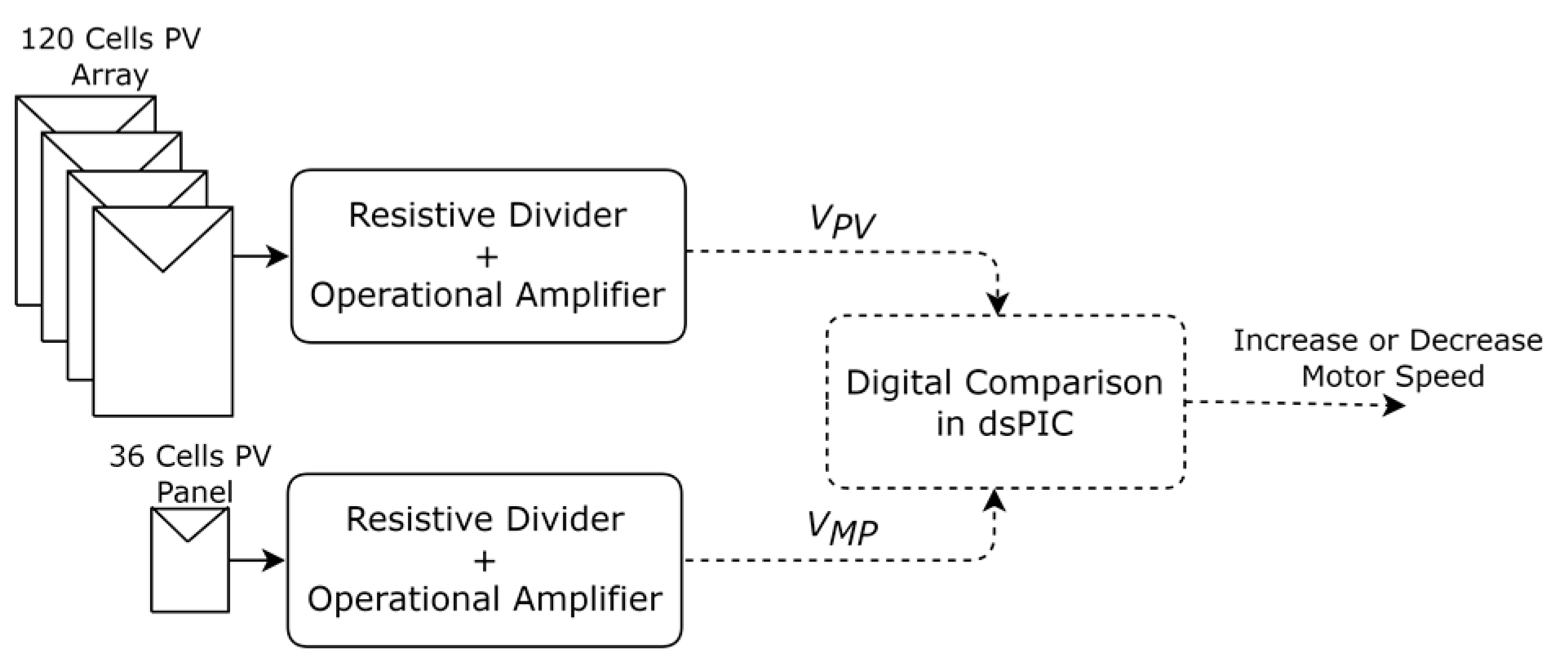
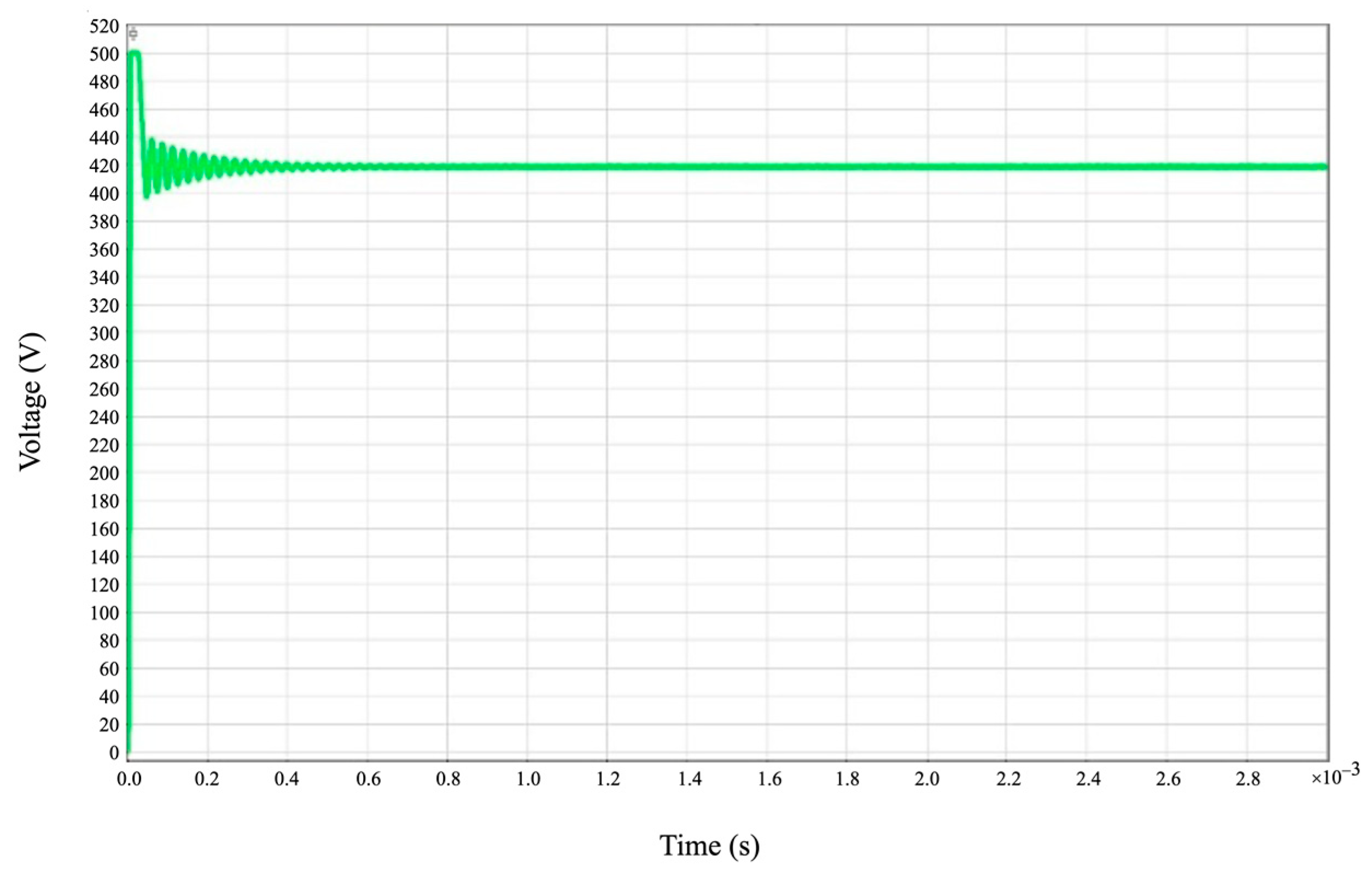
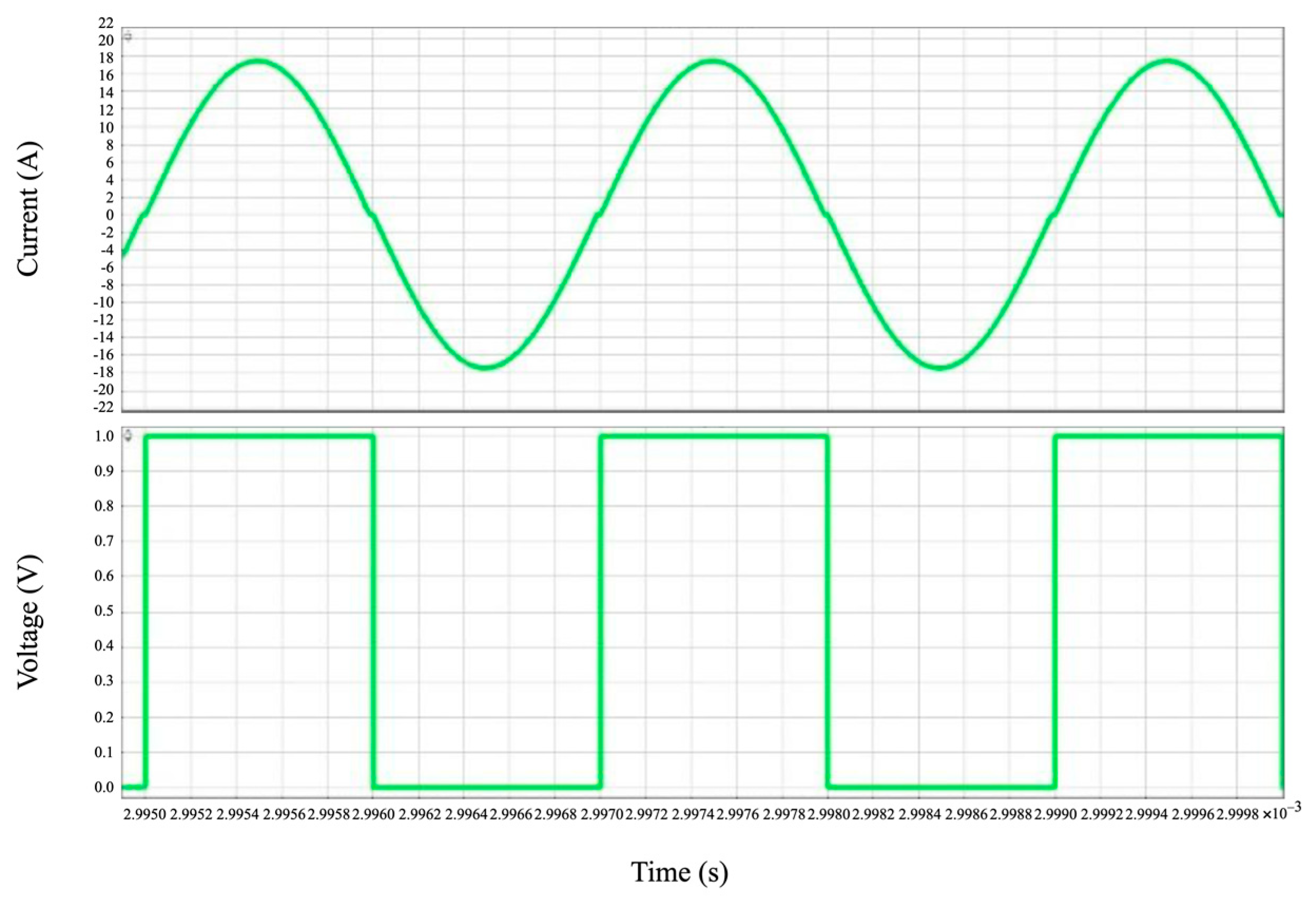

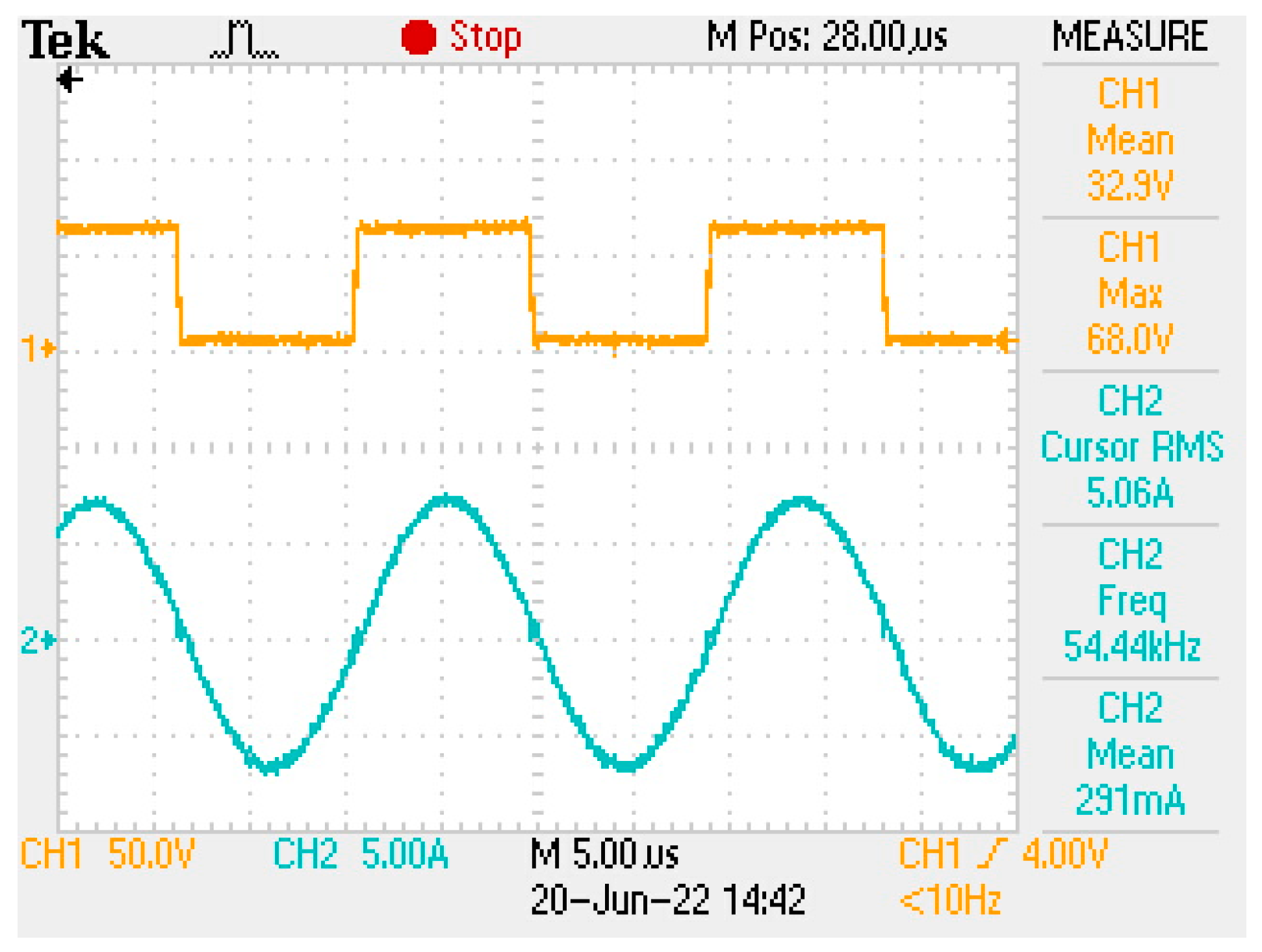

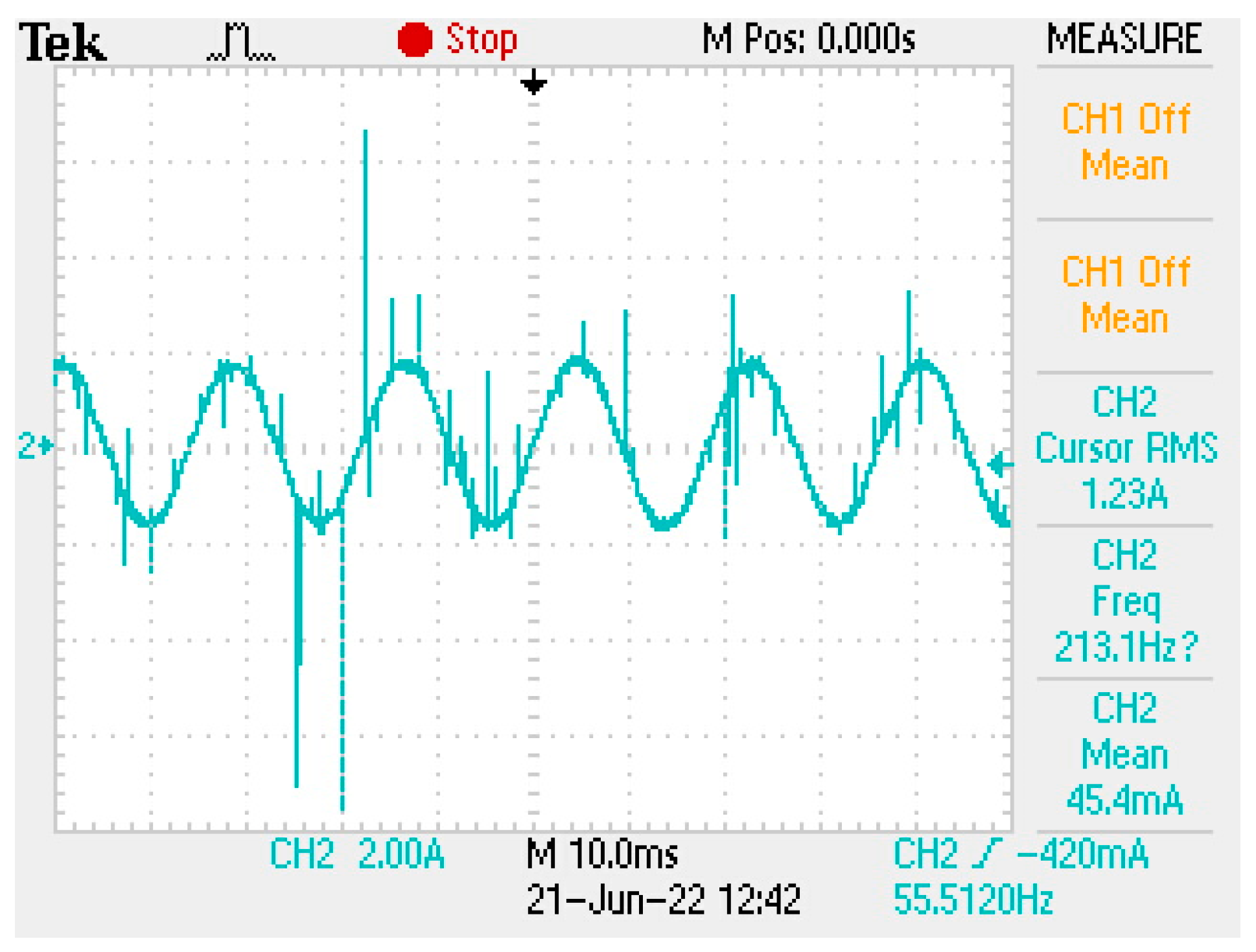
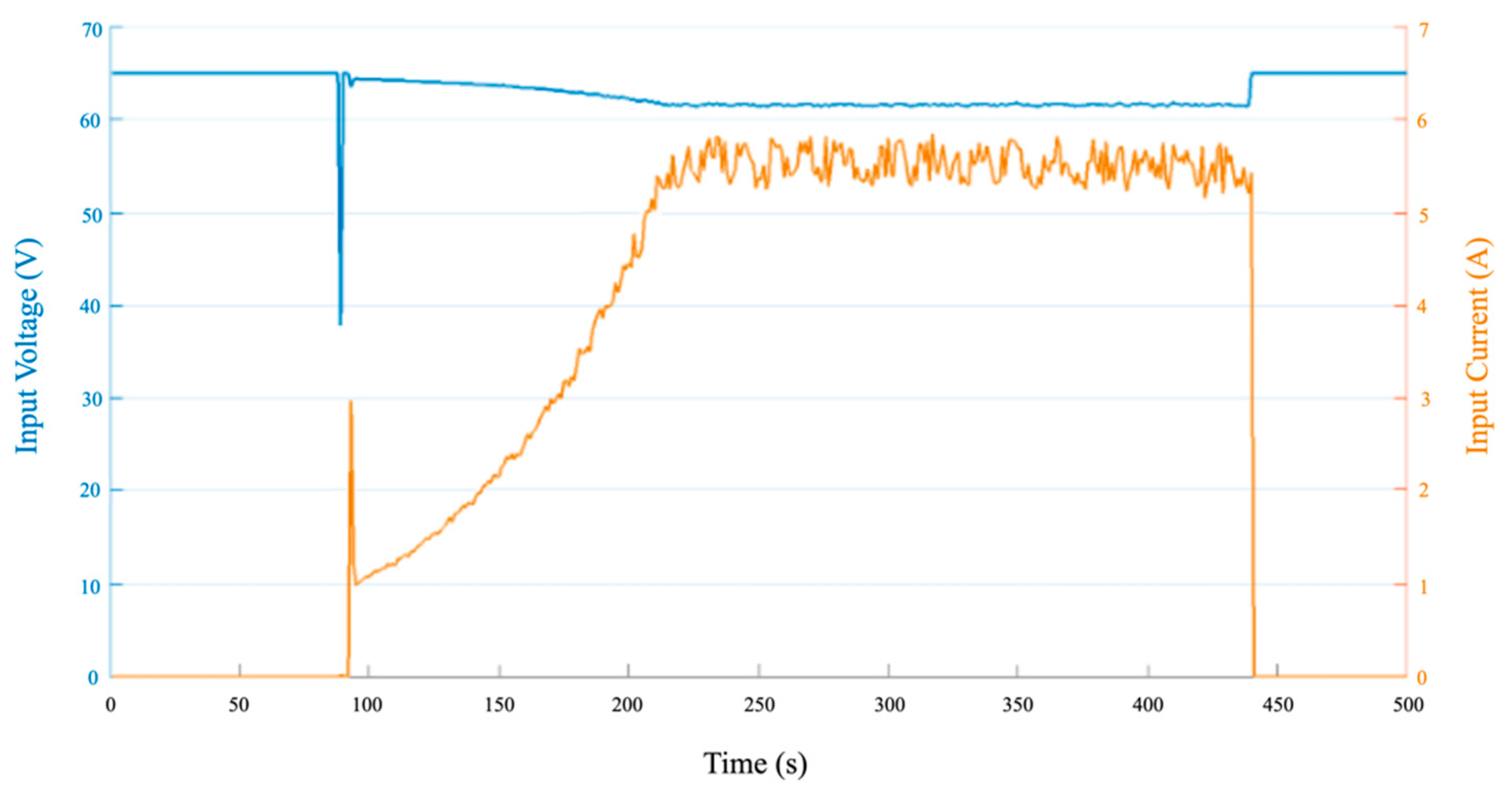
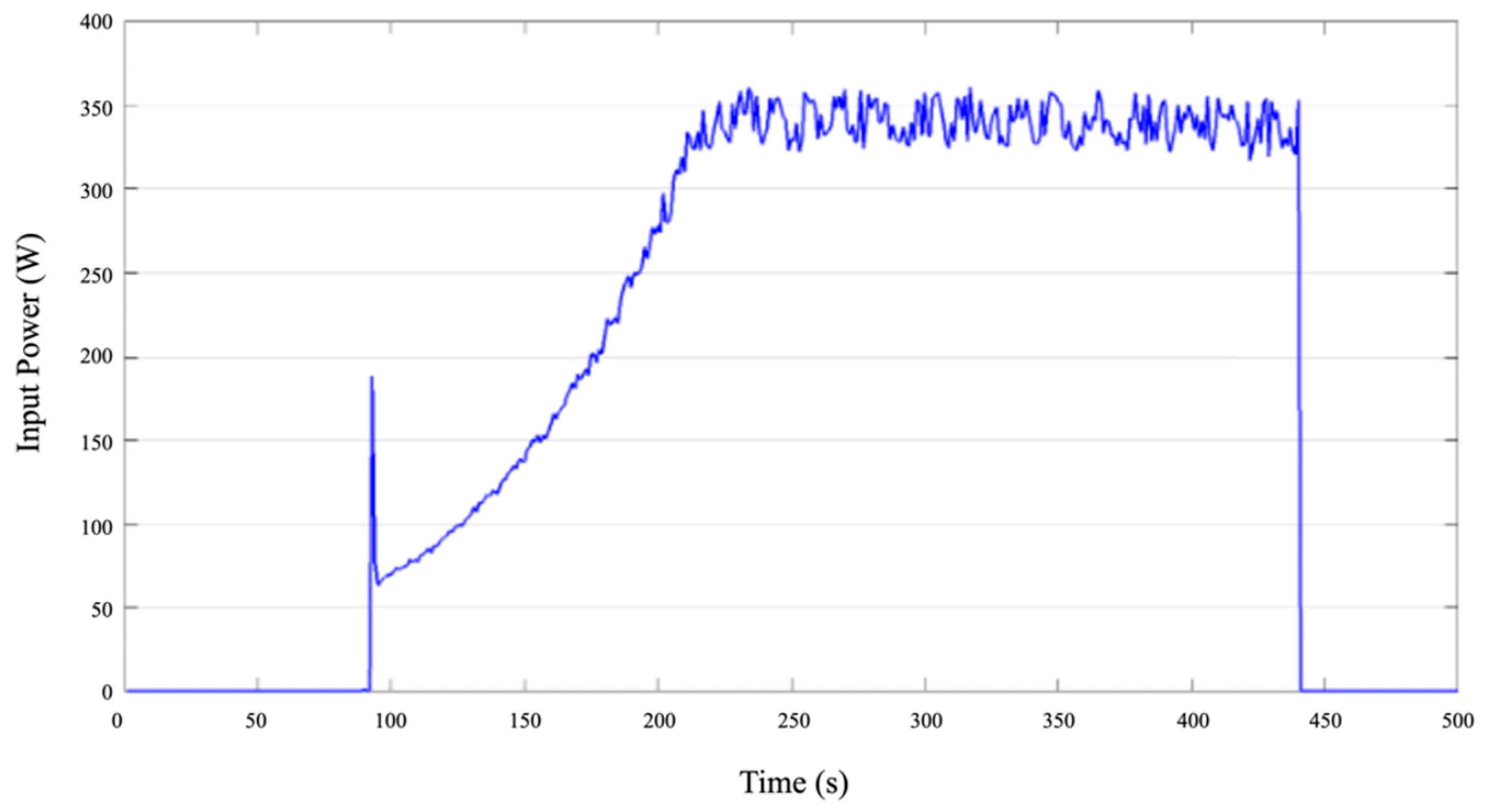

| Item | Specification |
|---|---|
| Capacitance— | 4 × 470 nF = 1.88 F |
| Inductance— | 3900 nH |
| Frequency— | 58.7 kHz |
| Components | Specification |
|---|---|
| Primary switches—SW1–SW4 | Mosfet SiC 750 V—UJ4C075018K3S |
| Input capacitor—C2 | F 100 V electrolytic + F ceramic |
| Resonant inductor—L1 | ~3900 nH, 5× AWG20 litz cable, 3× iron powder core |
| Resonant capacitor—C1 | 4 × 470 nF 630 V film |
| Transformer | 6:20 NEE 42/21/20 |
| Rectifier diodes | 30ETH06 30 A 600 V |
| Rectifier capacitors | 8 250 V polyester |
| DC Bus capacitors | F 600 V polyester |
| Inverter mosfets | Mosfet SiC 750 V—UJ4C075018K3S |
| Gate drives | 600 V IR2113 |
| Item | BRL Cost | USD Cost |
|---|---|---|
| PCB | 5.26 | |
| National electronics | 185.82 | |
| Imported electronics | 20.92 | |
| Heatsink | 72.00 | |
| Box | 140.00 | |
| Electric Miscellaneous | 60.00 | |
| Iron powder cores | 20.40 | |
| Total | R$607.89 | 122.73 USD |
| Item | BRL Cost | USD Cost |
|---|---|---|
| Power converter | 607.89 | |
| 4 × 280 Wp panels | 2560.00 | |
| 10 W panel | 100.00 | |
| Water pump | 1600.00 | |
| Total | R$4867.89 | 982.80 USD |
Disclaimer/Publisher’s Note: The statements, opinions and data contained in all publications are solely those of the individual author(s) and contributor(s) and not of MDPI and/or the editor(s). MDPI and/or the editor(s) disclaim responsibility for any injury to people or property resulting from any ideas, methods, instructions or products referred to in the content. |
© 2023 by the authors. Licensee MDPI, Basel, Switzerland. This article is an open access article distributed under the terms and conditions of the Creative Commons Attribution (CC BY) license (https://creativecommons.org/licenses/by/4.0/).
Share and Cite
Palmiro, F.; Godoy, R.B.; Mateus, T.H.d.A.; de Andrade, N.D. A 600 W Photovoltaic Groundwater Pumping System Based on LLC Converter and Constant Voltage MPPT. Energies 2023, 16, 4926. https://doi.org/10.3390/en16134926
Palmiro F, Godoy RB, Mateus THdA, de Andrade ND. A 600 W Photovoltaic Groundwater Pumping System Based on LLC Converter and Constant Voltage MPPT. Energies. 2023; 16(13):4926. https://doi.org/10.3390/en16134926
Chicago/Turabian StylePalmiro, Flavio, Ruben B. Godoy, Tiago H. d. A. Mateus, and Nicholas D. de Andrade. 2023. "A 600 W Photovoltaic Groundwater Pumping System Based on LLC Converter and Constant Voltage MPPT" Energies 16, no. 13: 4926. https://doi.org/10.3390/en16134926








